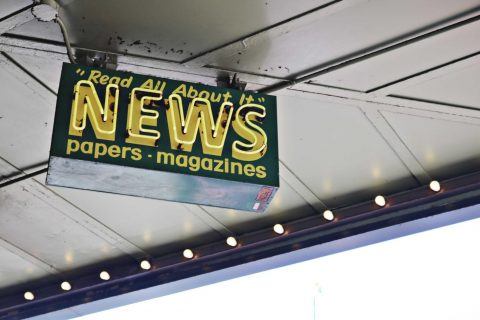If you’re looking for a guide on how to write a press release then you’ve come to the right place. There are many advantages to using press releases as part of your PR or marketing strategy. Not only are they great tools for persuading journalists to feature news about your organisation, but press releases can also be hugely beneficial in helping you to seed out favourable brand messages and secure backlinks that support your SEO strategy.
If you haven’t written a press release before, or need some help brushing up on your press release writing skills, then read on. This guide on how to write press releases will cover:
- Understanding What a Press Release is For
- How To Structure A Press Release
- A Press Release Template Example
- Tips on How To Write Effective Press Releases
We also cover the most important aspects of press release writing, such as: what a press release is for, what a press release should include, how to end a press release, what format press releases should be presented in and how to structure your press release.
What is a Press Release For?

In short, a press release is a written document featuring news relating to your organisation. Press releases are used to pitch to journalists with the aim of securing media coverage for your business or backlinks to your website (for SEO).
However, before you start writing it is important to understand what a press release is and is not. First identify your target audience and the target media. This may sound obvious, but it is important to note. While your target audience are the prospects you want to engage, your target media are the media outlets in which you want your business to be featured. It does not always follow that what appeals to one will always appeal to the other.
For example, you might be targeting a specific online publication because you want a backlink from that outlet to support your SEO strategy. But the audience profile of that media outlet may be different to your typical target customer.
Even if the target audiences are only slightly different, the way you write your press release can make a big difference. Journalists are often under a strict brief to carry content on their sites that appeal directly to their readers, not your target audience. You are asking them for free exposure. So you’ll need to at least meet them halfway by writing your press release with their audiences in mind. Otherwise you will likely be unsuccessful in achieving a media placement there.
Writing press releases and other PR materials is different to writing for most marketing channels. That’s because marketing materials are normally presented direct to the consumer. Press releases are not.
Press releases are also not sales tools and a common pet hate for journalists is overtly commercial or salesly language in press releases and media pitches. Your press release needs to be editorially focused; that is written as a news story or short article to engage and entertain audiences. This is actually a strength of PR, as being endorsed by a journalist (and not trying to sell straight away) builds engagement, trust and credibility around your brand.
Remember, your press release is foremost a tool to persuade journalists to feature your business. While a journalist might use your press release as a starting point for a story, most quality media outlets do not print press releases verbatim. Instead, they are likely to edit your press release based on their readership, house style or another angle that better suits their media brand.
If you want your press release to be successful, you need to write it with your target media in mind. Of course, it is perfectly acceptable to subtly weave important key messages into your press release. However, the core story behind your press release has to appeal to your target media if you want to gain traction there.
If you want to reach specific target audiences through PR, I recommend first establishing the target media they read. Then engineer your press release and PR story to appeal to that target media. Don’t fall into the trap of trying to bypass the media altogether by writing a press release targeted solely at your ideal customer – it won’t work.
How to Structure a Press Release

Before you get writing, take the time to plan the structure of your press release. There are many different styles of press releases and it is common to see variations between organisations when it comes to aspects such as spacing, typography, and layout.
However, most press releases tend to follow a very similar basic structure. This press release structure has been designed to ensure that your release is easy for journalists to read and use as a starting place for their own articles. It is also important that your press release is structured in such a way that the most salient parts of the PR ‘story’ can be quickly understood. Remember, some journalists get hundreds of press releases every day and have very little time to read them. Your press release needs to be clear, concise and effective in quickly demonstrating the most newsworthy parts of the story to cut through the noise.
Well structured press releases also show journalists that you are a PR professional who understands what they need – increasing the odds of them wanting to work with you.
Listed below are some of the most common components of a typical press release. These are listed in order, with the first components typically appearing at the top of the page.
Organisation logo in press releases
It is fairly common for organisations to place their logo at the top of the page, aligned to the left. This is a branding opportunity and is used in more corporate or formal press releases to quickly illustrate to journalists who the press release is from. It is not essential to include the company logo and some PRs choose to exclude it to make the press release feel less corporate and more editorial in nature. In either case, the logo should be relatively discrete so as not to detract attention from the headline of the press release.
Date and press release title label
At the top of the press release it is common for PRs to place the date of the story and a short title label. This notifies the reader as to where the press release begins and the date that it was first distributed to the media. In the UK, the date is often presented as DD/MM/YY or simply just as the month if the story is not time sensitive (e.g. July 2022). The title label is usually just a couple of words to illustrate what the press release is (E.g., ‘Press Release or ‘For Immediate Release). It is common for these to be presented in a standard size font, on separate lines, aligned to the right and underneath the company logo (but above the press release headline).
The press release headline
This is arguably the most significant part of the press release as your headline is what journalists will tend to read first. Your headline needs to:
- Quickly illustrate the most newsworthy part of the story.
- Be well presented and easy to read and understand. If a journalist has to strain to read it, or read it several times to understand it, then chances are it will get binned.
- Be catchy and engaging to read. The story needs to be summarised in the headline as interesting, new and newsworthy.
- Be topical to the news agenda. Demonstrating the relevance of your press release to a significant current news story often makes a press release more interesting to journalists. However, I advise against doing this if the link is weak or tenuous (as this could discredit the whole story).
- Be concise and easy to read. This is to avoid overcrowding the page or making the headline cumbersome to read. People have surprisingly short attention spans; so your headline really does need to concisely communicate the crux of your story as efficiently as possible.
- Presented as at least 1-3 point sizes larger than the body text of the press release.
The headline you choose can be the ‘make or break’ moment of your press release. Remember, some journalists are sent hundreds of press releases every day and will make a decision about the strength and relevancy of your story very quickly based on this. If you don’t use your headline to quickly, concisely and comprehensively illustrate why the story is newsworthy and relevant to their audience, then it may not even get read.
Imagery in press releases
Depending on the subject matter of your press release, an image embedded within the copy can be very helpful in bringing your story to life. This is because journalists will also be assessing whether your press release is something that they could present to their readers in an engaging way.
Using imagery (between the headline and introductory paragraph) provides an opportunity to encourage journalists to ‘buy in’ to your press release by showcasing how it ‘fits’ with their media platform. Try to include an image that is relevant to that media publication and the story in your press release. If your press release is about a product, choose a flattering ‘lifestyle’ shot of it in action. Note that many publications will not run doctored images or pictures that include lots of company branding.
You may also want to consider using a professional photographer or high quality stock imagery that provides a strong, relevant illustration of the story of your press release. However it is important to ensure that the image is not overly generic and is appropriate for the publications you are pitching to. You can assess this by comparing it to other images that that your target media use in articles on site. High resolution (at least 300 dpi) imagery is often required for use in publication, so ensure your image is large enough.
Whether you decide to include an image in the body of your press release or not, many journalists will expect you to be able to supply an image alongside it.
Introductory paragraph of your press release
This is arguably the second most important aspect of your press release, as it is the first thing that a journalist will read after the headline.
Remember your press release is not a feature article. You’re not opening a novel and the introductory paragraph isn’t meant to be about going off on a tangent or trying to set the scene too much. Instead, think of your introductory paragraph as an extension of your headline. Keep in short (perhaps 3-4 sentences maximum) and use this paragraph to summarise the crux of the PR story at a top level. There will be plenty of time to move into the detail later, but here you want to engage the journalist by telling them, in a nutshell, exactly what the story is and why it’s relevant.
To summarise your story in the introductory paragraph, you’ll need to cover the ‘five Ws’:
- What is it?
- Who is involved?
- Where is this happening?
- When is it? / What are the key dates?
- Why is this happening? What is the purpose of this news?
- You may also want to cover ‘how’ this development is coming about
You’ll want to summarise all of the most salient information in the introduction. But remember this still needs to engage and court journalists. Your aim with this paragraph should be to make the reader feel like your press release is a killer news story, ideally in less than 15 seconds. No enjoys reading a huge wall of text. So keep it punchy, short and interesting. You can move into the details later on in your press release.
Throughout your press release, ensure that any statements, quotes or statistics are factually correct and state where this information is from. For example, if you quote a statistic from the Office of National Statistics to bolster your argument, it is good practice to name check them here. You should also reference them in your Boilerplate (see below).
The body text of your press release
These are the paragraphs that follow your introductory paragraph. The body text is all about filling out the rest of the PR story and going into more detail about the subject matter of the release. Refer back to the ‘five Ws’ (see the section above) to ensure that you cover all bases and provide everything that a journalist might need.
In terms of the structure, try (where possible) to include the most newsworthy and salient information nearer to the top of the page to keep it engaging. However, your press release also needs to flow smoothly. This means that your statements and data points need to be presented together in a logical and easy to grasp order. Avoid jumping back and forwards between different points. Your press release should build a coherent narrative that moves gracefully from one point to another.
While the detail is important here, don’t forget that these paragraphs still need to read like a news story. This means using language which inspires interest, and even entertains the reader. It also means being concise. Pages of text is not just a turn off to the reader, it also creates a larger editing job for the journalist and that can be off putting too. The ideal length for a press release is normally around 1-1.5 A4 pages long, depending on the size and significance of the story. Try to be tough with yourself and as concise as possible without losing the narrative or crucial information.
Using quotes in press releases
It is common for press releases to include a short quote (often one short paragraph) from a key spokesperson within the body of the press release. There is no hard and fast rule about where this should sit, however it normally makes sense for this to sit towards the end of the press release.
The purpose of the quote is to add commentary from an expert (or other relevant person involved) to reflect on the significance of your story for readers. For example, if your press release is about a new product launch you might want to focus on the significance of the product compared to others and what that means for readers. Ask yourself, why is this significant (to someone not involved in your organisation)? If I was a reader, why would this matter to me?
You will also need to attribute this quote to a relevant spokesperson within your organisation. The media will usually want to quote someone who will be seen as an expert or authority on the subject matter at hand. For press releases about significant news company updates, that might be the Managing Director or CEO. However, it can sometimes be more fruitful to use specialists within your organisation where relevant for the story. For example, a quote from a GP or medical professional in relation to the health benefits of a new product will often carry more weight with the media than a senior member of your organisation.
The press release boiler plate
The boiler plate is all about signalling the end of the press release and providing additional company information and contact details. Before signing it off, you may want to conclude your press release with a call to action that also includes a link to where journalists can find more relevant information. Ideally this will be hosted on your website. At the end of the body text it is standard practice to add a marker such as ‘‘-ENDS-’ to illustrate this.
Below this, you can include three short paragraphs (where relevant) with subheadings covering:
- About {Insert Organisation Name} – this is where you can include more detail about your organisation, key facts about what it does, how large it is and key messages.
- Sources – if you have made non-subjective claims or quoted statistics in the body of the release then these will need to be backed up with evidence. This is where you can provide links to official sources (either on your own website or third party sources) and salient information about the types of sources you’ve quoted and why. Remember to also name check sources in the body text when using third party statistics.
- Contact Details – provide the email address and telephone number for journalists to contact for more information. This should be someone responsible for your PR and able to handle media enquiries.
Press Release Template Example
We have included below a brief template guide for a standard press release to help you get started:
Company Logo (left aligned)
For Immediate Release (right aligned)
01/08/2022 (right aligned)
Headline (centre aligned, 2 point sizes larger than body text)
Image (centre aligned, medium size)
Introductory Paragraph (left aligned)
*Include information on what, where, who, why, when, how*
Paragraph 2 (left aligned)
Paragraph 3 (left aligned)
Paragraph 4 (left aligned)
Paragraph 5 (left aligned)
Quote from organisation expert (left aligned. E.g. “Managing Director John Smith commented:”)
Sign off (left aligned. E.g. ‘For More information, visit https://XXX)
-ENDS- (centre aligned)
About Organisation (left aligned)
*Insert key information about your organisation here*
Sources (left aligned)
(For example – Office of National Statistics data sources from: https://www.ons.gov.uk/XXX)
Media Contact Details (left aligned)
name@comany.co.uk
01234 567 899
Tips on How to Write Effective Press Releases

Listed below we have included a few more tips that you will want to keep in mind when it comes to writing a great press release:
- Keep it punchy and to the point – we’ve mentioned this throughout, and it is really important. The easier to read and the more newsworthy and interesting it is, the better.
- Showcase your trustworthiness early on. Make clear in your press release where or who the story is from and that the information in it is backed up by credible expertise. For example, if you are writing a press release on the results of a survey you will want to mention the size of the survey and relevance of the sample in the opening paragraph. This helps to inspire trust that the data to follow is credible and reliable.
- Focus on why your story is relevant to your target media. Review your press release to ensure that it’s relevant to the audience of the publications you are targeting it at. The more a journalist sees your press release as relevant to the readers, the more likely they are to feature it.
- Consider bullet points and subheadings. No one likes reading a wall of text and breaking down key facts and salient points in this way can make your press release easier for the reader to digest. This is often most appropriate if your press release contains a lot of data or covers a lot of ground.
- Link back to your website. Remember to link back to your organisation’s website within the press release. We suggest doing this as a hyperlink on the name of your organisation. One or two links is ideal.
- Be timely. Where possible try to create and send press releases that are timely to the news agenda. This will increase its appeal to journalists.
- Quadruple check the details. The details matter as journalists need to know that they can count on you to provide factual, accurate information that they can publish with confidence. Once you have written your press release, review it, edit it, proof it, and double check all references and sources. At this stage it is also useful to double check that the story still feels newsworthy and relevant to the media sectors you plan to pitch it to.
- Set up an approvals process. Remember your press release is external communications for your business and as a result you will need to get the press release approved before releasing it to the public. Work with your team and managers to figure out exactly who needs to approve what and be clear to others on your expectations around deadlines for approval. Our advice is to only engage relevant stakeholders with media experience if that is possible; sometimes too many cooks really do spoil the broth and can slow you down.
- Pitch your press release in the right way. Exactly how you should do this is context dependent based on the story, the industry sector and type of media you are trying to engage. However, if you are pitching via email, we recommend including the press release within the body of the email with a personalised note above your press release to the journalist. Attaching your press release as a pdf of word document runs the risk of your email landing in spam boxes.
We hope you found this guide on how to write a press release useful. For more useful PR tips and advice checkout our Digital PR blog. In addition, we’re also able to help brands deal with or plan for crisis PR.


Leave a Reply